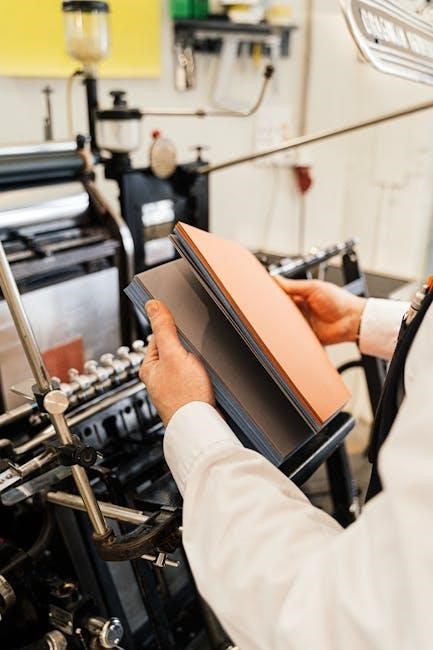
The Kenmore bread machine manual provides a comprehensive guide for operating and maintaining your bread maker, offering detailed recipes, troubleshooting tips, and maintenance advice for optimal performance.
Features
The Kenmore bread machine offers multiple preset programs, delay start, rapid baking, and customizable crust color options, ensuring versatile and convenient bread-making experiences for home bakers.
Design
The Kenmore bread machine features a sleek and compact design, making it a perfect addition to any kitchen countertop. Its user-friendly interface includes a large LCD display and intuitive buttons for easy navigation. The machine is built with durable materials, ensuring long-lasting performance. The non-stick bread pan and kneading paddle are designed for effortless dough handling and easy cleaning. The compact size allows for convenient placement without occupying too much space. The design also includes a viewing window, enabling users to monitor the baking process. Additionally, the machine supports various loaf sizes and crust color preferences, catering to different baking needs. The overall design emphasizes functionality, durability, and ease of use, making it a practical choice for both novice and experienced bakers.
Customization

The Kenmore bread machine manual highlights various customization options to tailor your bread-making experience. Users can adjust settings like crust color, loaf size, and delay timers for convenience. The machine also allows for custom recipes, enabling you to experiment with different ingredients and flavors. Additionally, some models offer programmable settings to save your favorite recipes for quick access. The manual provides guidance on how to modify preset settings to achieve desired textures and tastes. Whether you prefer classic white bread or artisanal whole-grain loaves, the Kenmore bread machine empowers you to create personalized bread with ease. This flexibility makes it ideal for both novice bakers and experienced enthusiasts seeking unique results.
Settings
The Kenmore bread machine manual details various customizable settings to tailor your bread-making experience. Users can adjust settings like delay start, crust color, and loaf size. The control panel offers intuitive buttons for selecting modes, such as basic, rapid, or gluten-free options. Additional settings include yeast activation and dough-only cycles. The manual emphasizes the importance of proper configuration to ensure optimal results. Advanced models may include programmable timers and memory functions. Refer to the manual for specific instructions on navigating and customizing these settings to suit your preferences and recipe requirements.
- Delay start timer for convenient baking.
- Crust color options (light, medium, dark).
- Loaf size adjustments (small, medium, large).

Accessories
The Kenmore bread machine manual highlights essential accessories to enhance your baking experience. These include a non-stick bread pan, kneading paddles, and a measuring cup for precise ingredient measurements. Additional accessories like a dough hook and scraper are useful for handling sticky dough. The manual also recommends using a cooling rack to prevent sogginess after baking. Optional accessories, such as a recipe booklet, provide inspiration for various bread types and settings. Ensure all parts are dishwasher-safe for easy cleaning. Accessories may vary by model, so refer to your specific manual for details. Using genuine Kenmore accessories ensures compatibility and optimal performance. Always store accessories safely to maintain their condition and functionality.

Installation
Installation involves unpacking, placing the machine on a stable surface, and ensuring proper setup according to the manual’s safety guidelines for optimal functionality and user safety.

Unpacking

When unpacking your Kenmore bread machine, carefully remove the appliance from the box and inspect for any visible damage. Ensure all accessories, such as the bread pan, kneading paddle, and measuring cups, are included. Gently wipe down the exterior and interior with a soft cloth to remove any packaging residue. Before first use, read the manual to familiarize yourself with the machine’s components and features. Place the bread maker on a stable, flat surface away from direct sunlight and heat sources. Check that all parts are securely attached and functioning properly. This ensures a smooth and safe initial setup process. Proper unpacking is essential for maintaining the machine’s performance and longevity. Always follow the manufacturer’s guidelines for handling and placement.
Placement
Proper placement of your Kenmore bread machine is essential for safe and efficient operation. Place the machine on a stable, flat surface, such as a countertop, ensuring it is level to prevent uneven mixing. Avoid areas near direct sunlight, moisture, or extreme temperatures, as these can affect performance. Keep the machine away from heat sources like ovens or stovetops to avoid overheating. Ensure there is adequate space around the machine for proper ventilation. Do not place it in enclosed spaces, as this may restrict airflow and lead to operational issues. Always position the machine on a heat-resistant surface to protect your countertop from potential heat exposure during use.
Setup
Setting up your Kenmore bread machine is straightforward. Begin by carefully unpacking the unit and placing it on a stable, heat-resistant surface. Plug in the machine, ensuring it is positioned away from children and flammable materials. Next, set the clock according to the manual’s instructions, as this is essential for timing functions like delayed start; Familiarize yourself with the control panel, including buttons for cycle selection, crust color, and loaf size. Before first use, wipe the bread pan and kneading paddle with a damp cloth to ensure cleanliness. Refer to the manual for specific setup steps, as some models may require initial calibration or software updates. Proper setup ensures optimal performance and safety. View manual for detailed guidance.
Safety
Always prioritize safety when using your Kenmore bread machine. Ensure the appliance is placed on a stable, heat-resistant surface away from flammable materials. Keep children away during operation. Avoid overheating by not leaving the machine unattended. Regularly inspect the power cord and plug for damage. Never immerse the machine in water or expose it to excessive moisture. Use oven mitts when handling the hot bread pan or lid. Follow the manual’s guidelines for proper ventilation to prevent carbon monoxide buildup. Store the machine in a cool, dry place when not in use. Adhere to all safety precautions to ensure safe and efficient operation of your Kenmore bread maker.
Operating
Learn how to start, navigate the menu, adjust settings, and monitor your Kenmore bread machine for optimal performance and consistent baking results every time.
Starting
To start your Kenmore bread machine, ensure the bread pan is properly placed and secured inside the machine. Plug in the unit and select your desired settings using the control panel. Choose the appropriate loaf size, crust color, and baking mode. Add ingredients in the recommended order: liquids first, followed by dry ingredients, and yeast last. Close the lid and press the “Start” button to begin the cycle. The machine will automatically mix, knead, rise, and bake the dough. Allow the cycle to complete without opening the lid. Once done, let the bread cool before slicing. Always refer to the manual for specific settings and troubleshooting tips to ensure optimal performance. Proper initialization ensures a perfect loaf every time.
Menu
The Kenmore bread machine menu offers a variety of preset settings to suit different baking needs. Users can choose from basic, advanced, and gluten-free options, ensuring versatility for any recipe. The menu also includes a super rapid mode for quick bread preparation. Additional features like crust color selection and delay start allow for customization. The interface is user-friendly, with clear buttons and an LCD display for easy navigation. The menu caters to both beginners and experienced bakers, providing options for yeast-based, whole grain, and specialty breads. This flexibility ensures that the Kenmore bread machine adapts to various preferences and dietary requirements, making it a convenient and efficient kitchen appliance.
Adjusting
Adjusting your Kenmore bread machine allows for personalized bread-making experiences. The machine offers customizable settings such as delay start, crust color, and loaf size. Users can choose from various pre-programmed menu options, including settings for gluten-free, whole wheat, and rapid baking. The crust color can be adjusted to light, medium, or dark, ensuring the perfect texture. Additionally, the loaf size can be set to accommodate 1, 1.5, or 2-pound loaves. The delay start feature enables you to prepare ingredients and set the machine to begin baking at a later time, providing convenience for busy schedules. These adjustable features ensure flexibility and precision, catering to diverse preferences and dietary needs. Refer to the manual for specific instructions on navigating the menu and saving custom settings for optimal results.
Monitoring
Monitoring your Kenmore bread machine ensures optimal performance and consistent results. The display screen shows real-time progress, allowing you to track the baking cycle. Regularly check the dough through the glass lid to ensure proper mixing and rising. Listen for unusual noises, as they may indicate issues. Always smell the bread to confirm it’s baking correctly. Check the machine’s temperature and adjust settings if necessary. Keep an eye on ingredient levels to avoid overfilling. Clean the viewing window for clear visibility. Monitor the bread’s crust color to prevent over-browning. Regularly inspect belts and pans for wear. Proper monitoring helps maintain your machine and ensures delicious bread every time. Follow manual guidelines for best results.

Recipes
The Kenmore bread machine manual includes a variety of recipes, from basic bread to advanced gluten-free options, with detailed instructions and measurements for perfect results every time.
Basic
The Kenmore bread machine manual includes a variety of basic recipes to get you started with bread making. These recipes are simple and require minimal ingredients, such as flour, yeast, salt, sugar, and water. The manual provides step-by-step instructions for classic white bread, whole wheat bread, and basic dough settings. It also covers essential tips for measuring ingredients accurately and understanding the machine’s cycles. Beginners can start with the “Basic” mode, which offers a straightforward process for creating delicious homemade bread. The manual emphasizes the importance of using the right type of flour and yeast for optimal results. With these foundational recipes, users can experiment with additional ingredients to create personalized bread variations.
Advanced
For experienced users, the Kenmore bread machine manual offers advanced recipes and techniques to elevate your baking skills. Explore complex dough preparations, multi-grain blends, and artisanal bread recipes. Utilize special settings like rapid bake or delay start for convenience. Customize recipes by adjusting yeast ratios, flour types, and add-ins like nuts or seeds. The manual provides tips for achieving crust perfection and ensuring even baking. Advanced users can also experiment with gluten-free and sourdough recipes, tailored for the Kenmore machine. Detailed instructions guide you through troubleshooting common issues and optimizing results. With these advanced features, you can create professional-quality bread effortlessly at home.
Gluten-Free
The Kenmore bread machine manual includes a section dedicated to gluten-free baking, offering recipes and tips for creating delicious gluten-free bread. Users can explore various gluten-free flour options and settings to achieve the perfect loaf. The manual provides guidance on adjusting ingredient ratios and cycle selections to accommodate gluten-free needs. Additionally, it highlights the importance of precise measurements and the role of xanthan gum or guar gum in enhancing texture. For models like the Kenmore 48487 and 100.12934, specific settings are recommended to ensure optimal results. The manual also includes troubleshooting tips for common gluten-free baking challenges, such as dense textures or poor rise. This section is a valuable resource for those with dietary restrictions, ensuring they can enjoy homemade bread with ease.
Troubleshooting
Common issues with the Kenmore bread machine include the machine not turning on, uneven mixing, or poor crust color. If the machine doesn’t start, check the power cord and ensure it’s properly plugged in. For uneven mixing, verify that ingredients are added correctly and the dough is evenly distributed. Poor crust color may result from incorrect temperature settings or insufficient baking time. Consult the manual for specific error codes and solutions. Regular cleaning and proper maintenance can prevent many issues. If problems persist, refer to the troubleshooting section in the manual or contact Kenmore support for assistance. Always follow safety guidelines to avoid damage or injury.
Maintenance
Regular cleaning and proper upkeep ensure longevity and optimal performance of your Kenmore bread machine, with troubleshooting tips to address common issues and maintain functionality effectively.
Cleaning
Regular cleaning of your Kenmore bread machine is essential for maintaining its performance and longevity. Start by unplugging the machine to ensure safety. Remove the bread pan and kneading paddle, washing them with warm, soapy water. Use a soft cloth to wipe down the exterior, avoiding abrasive cleaners that could damage the finish. For tough crumbs inside the machine, brush them out gently or use a damp cloth. Never submerge the machine in water or use harsh chemicals, as this can damage electrical components. After cleaning, dry all parts thoroughly to prevent rust or mold. Regular maintenance ensures your bread maker continues to function optimally and produces delicious results. Always refer to your manual for specific cleaning instructions tailored to your model.
Regular
Regular maintenance ensures your Kenmore bread machine operates efficiently. After each use, clean the bread pan and kneading paddle with a damp cloth, removing any dough or crumbs. Check for residue in the machine’s interior and wipe it down. Avoid using harsh chemicals or abrasive cleaners, as they may damage the finish. Dry the machine thoroughly after cleaning to prevent rust. Every few months, inspect the power cord for damage and ensure the machine is placed on a stable, even surface. Regular upkeep helps maintain performance and extends the lifespan of your bread maker. Refer to the manual for specific cleaning instructions tailored to your model.
The Kenmore bread machine manual includes a dedicated section for troubleshooting common issues. Users can address problems like faulty sensors, uneven mixing, or power failures. The guide offers solutions such as checking the power supply, ensuring the lid is properly closed, and cleaning the bread pan. It also covers error codes, providing step-by-step fixes to restore functionality. Additionally, the manual advises on how to handle dough that doesn’t rise or bake evenly, suggesting adjustments to yeast, temperature, or ingredient measurements. For more complex issues, the troubleshooting section recommends consulting the warranty or contacting customer support. This resource helps users resolve problems efficiently, ensuring optimal performance and consistent results. Refer to the manual for detailed guidance on diagnosing and resolving specific malfunctions.

Common Issues
Common issues with Kenmore bread machines include improper dough formation, uneven baking, or machine errors, often addressed through troubleshooting steps outlined in the user manual.
Problems
Common issues with the Kenmore bread machine include the machine not turning on, uneven mixing, or the bread not baking properly. These problems can often be resolved by checking the power supply, ensuring proper ingredient measurements, and verifying the timer settings. Some users report issues with the dough not rising, which may be due to expired yeast or incorrect temperature settings. Additionally, the bread pan may sometimes stick to the machine, requiring gentle cleaning. For more complex issues, consulting the user manual or contacting customer support is recommended. Regular maintenance, such as cleaning the interior and ensuring all parts are securely locked, can help prevent these problems. Always refer to the manual for specific troubleshooting guidance.
Errors
Common errors with the Kenmore bread machine include issues like uneven baking, dough not rising, or the machine not turning on; These problems can often be resolved by checking the power supply, ensuring proper ingredient measurements, and verifying yeast activity. Incorrect settings or expired yeast are frequent culprits. If the machine fails to start, ensure it is properly plugged in and the outlet is functioning. For uneven baking, adjust the pan position or check for obstructions. Refer to the manual for specific error codes and troubleshooting steps to address these issues effectively and maintain optimal performance. Regular maintenance and proper usage can prevent many of these errors. Always follow the guidelines provided in the manual for best results.
FAQs
- Q: What is the ideal flour for bread making? A: Use bread flour with high gluten content for best results.
- Q: Can I open the lid during operation? A: No, opening the lid may disrupt the baking process.
- Q: How do I clean the bread pan? A: Wash with warm soapy water; avoid abrasive cleaners.
- Q: Why is my bread dense? A: Overmixing or insufficient yeast can cause this issue.
- Q: Can I use gluten-free flour? A: Yes, but adjust recipes and settings as needed.
- Q: Where can I find troubleshooting guides? A: Refer to the user manual or manufacturer support;

Tips

Regularly clean the bread pan and paddles for optimal performance. Experiment with ingredients and settings to customize recipes. Store the machine in a cool, dry place when not in use.
Best Practices
For optimal results with your Kenmore bread machine, always measure ingredients accurately and use bread flour for better rise. Avoid overmixing dough before adding it to the machine. Regularly clean the bread pan and paddles to prevent residue buildup. Follow the recommended ingredient order and liquid levels to ensure proper mixing. Experiment with recipes gradually, adjusting ingredients based on loaf texture. Store the machine in a cool, dry place when not in use. Refer to the manual for specific settings and troubleshooting tips to maintain performance. By adhering to these practices, you can achieve consistent, high-quality bread and extend the lifespan of your machine.
Customizing
The Kenmore bread machine manual highlights various customization options to tailor your baking experience. Users can adjust settings like crust color, loaf size, and delay start to suit their preferences. Custom recipes can be programmed using specific ingredient ratios and settings, ensuring personalized results. The manual provides guidance on how to input custom settings and troubleshoot common issues. Additionally, it offers tips for experimenting with different ingredients and flavors, allowing users to create unique bread recipes. The customization features make the Kenmore bread machine versatile, catering to both beginners and experienced bakers. By following the manual’s instructions, users can unlock the full potential of their machine and enjoy perfectly baked bread tailored to their taste. This flexibility ensures a satisfying and personalized baking experience every time.
Storage
Proper storage of your Kenmore bread machine ensures longevity and optimal performance. After cleaning, store the machine in a cool, dry place away from direct sunlight. Avoid humid environments to prevent moisture buildup. Keep the bread pan and accessories in a separate, dry container to maintain hygiene. If not in use for an extended period, unplug the machine and secure the cord to avoid damage. Store the user manual in a safe place for future reference. Always ensure the machine is out of reach of children when not in use. Regularly inspect stored parts for signs of wear or damage before reuse. Proper storage habits will help preserve your bread maker’s functionality and ensure it remains in great condition for years to come.
Warranty
The Kenmore bread machine manual outlines warranty details, including coverage periods, repair options, and contact information for customer support and service centers.
Info
The Kenmore bread machine manual is readily available online for various models, including the Kenmore 48487, 100.12934, and KTR2300. These manuals are provided in formats such as PDF, EPUB, and FULL TEXT, ensuring accessibility for all users. They can be downloaded from platforms like Internet Archive and ManualsLib. The manuals cover essential information, including usage guides, recipes, and troubleshooting tips. For instance, the Kenmore 48487 manual spans 25 pages, while the 100.12934 model’s manual is concise at 14 pages. These resources are designed to help users maximize their bread-making experience, offering detailed instructions and care tips to maintain the machine’s performance and longevity.
Support
Kenmore provides extensive support resources for their bread machine users. The official Internet Archive offers free downloads of user manuals, including the Kenmore 48487 and 100.12934 models, ensuring easy access to instructions. Additionally, ManualsLib hosts the Kenmore Easy Baking recipe booklet, which includes troubleshooting guides and maintenance tips. For further assistance, users can contact Kenmore’s customer support or refer to the detailed FAQs section in the manuals. These resources cover common issues, error codes, and repair options, helping users resolve problems efficiently. The manuals also provide contact information for authorized repair services, ensuring comprehensive support for all Kenmore bread machine owners.
Repair
The Kenmore bread machine manual includes a detailed repair section, offering troubleshooting guides and step-by-step instructions for common issues; It covers DIY fixes for faulty heating elements, malfunctioning paddles, and electrical problems. Users can address errors like stuck bread pans or uneven baking without professional help. The manual also provides tips for maintaining optimal performance and preventing future repairs. For complex issues, it advises contacting Kenmore support for authorized service. Regular maintenance, such as cleaning and lubricating moving parts, is emphasized to extend the machine’s lifespan. This section ensures users can resolve problems efficiently, keeping their bread maker in excellent working condition.
The Kenmore bread machine manual is an essential resource for users, offering detailed guidance on operation, maintenance, and troubleshooting. It provides clear instructions for making delicious bread, from basic to advanced recipes, ensuring optimal results. With sections on customization, safety, and regular maintenance, the manual helps users extend the lifespan of their machine. Troubleshooting guides and FAQs address common issues, while tips for best practices and storage enhance the overall experience. Whether you’re a novice or an experienced baker, the Kenmore bread machine manual empowers you to make the most of your appliance. Download the PDF manual today and enjoy effortless bread-making with Kenmore’s reliable support.